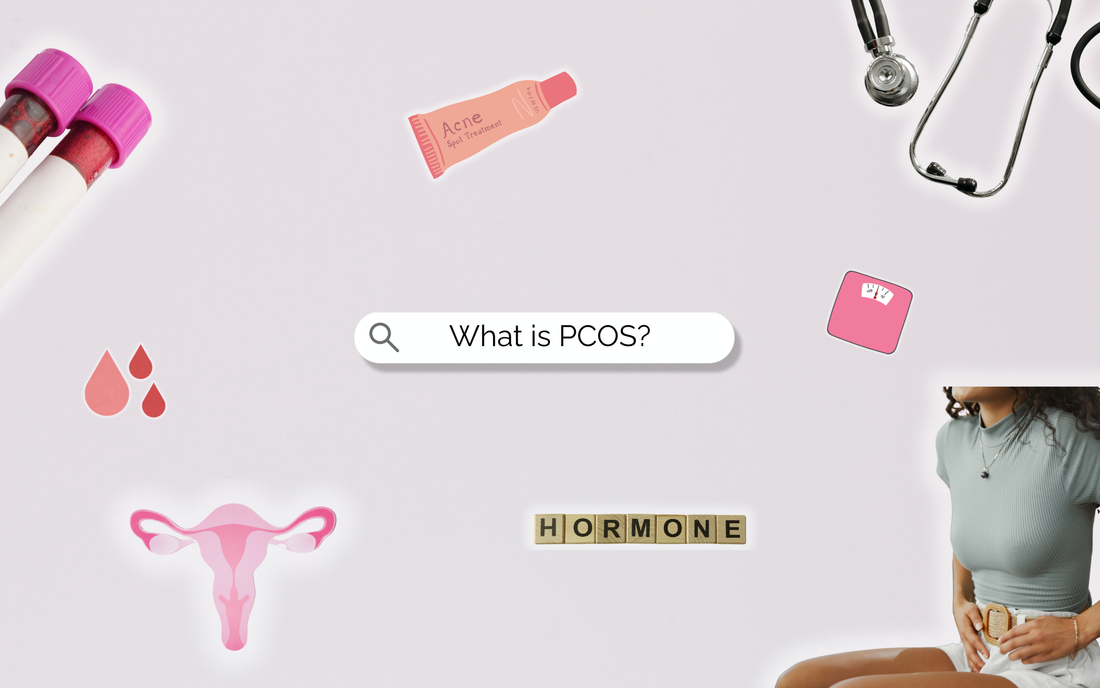Welcome to week one of our PCOS series for September’s PCOS Awareness Month. In this blog, we’re breaking down the basics: what PCOS actually is and how it’s diagnosed.
Maybe you’ve just been told by your doctor that you have PCOS and want to understand what that means. Or perhaps you’re still in the process of getting tests and are searching for answers. You might even be right at the very start of your journey, simply wondering: “Do I have PCOS?”
Wherever you are, this guide is here to give you clarity and help you feel a little less alone as you start piecing things together.
What is PCOS?
Polycystic Ovary Syndrome (PCOS) is the most common endocrine and metabolic condition affecting women of reproductive age – impacting up to 1 in 10 women worldwide.
In simple terms, PCOS changes the way your ovaries work and can affect your hormones, periods, fertility and even long-term health.
Despite the name, PCOS doesn’t actually mean you have “cysts” on your ovaries. Instead, the ovaries are often slightly larger than usual and contain many tiny follicles. Follicles are small, fluid-filled sacs that usually mature and release an egg during ovulation. In PCOS, however, hormonal imbalances can prevent these follicles from developing properly, meaning the egg isn’t released as it should. As a result, the ovaries may only release an egg irregularly – or sometimes not at all – a process known as anovulation.
What are the symptoms of PCOS?
Signs of PCOS often appear in the late teens or early 20s, though they can show up earlier or later. Not everyone with PCOS will experience the same symptoms, and their severity can vary widely. Some women may not notice anything unusual until they start investigating irregular periods or fertility concerns.
That said, one of the most common signs is changes to your period. These can look different for everyone and may include:
- Irregular or late periods
- Heavy or long periods
-
Intermittent, unpredictable or completely absent periods
Other common symptoms to look out for:
- Excess hair growth (especially on the face, chest, back or stomach)
- Thinning scalp hair or male-pattern baldness
- Acne or oily skin
- Food cravings, particularly for carbs or sugar
- Difficulty losing weight or easy weight gain (though PCOS affects all body types)
- Fertility challenges
- Mood changes like anxiety, depression or low mood
- Binge eating or disordered eating patterns
- Body image concerns
- Sleep disturbances or sleep apnoea
✨ Remember: not everyone with PCOS will experience all of these symptoms. For some women, symptoms are very mild – while for others, they may be more noticeable and impact daily life.
What is the Cause of PCOS?
The truth is, we don’t fully know what causes PCOS – but it’s likely a mix of genetics, hormones, lifestyle and environmental factors. If women in your family – like your mum, sister or aunt – have PCOS, your chances are higher.
Insulin Resistance:
Insulin is a hormone that helps your body manage blood sugar. Many women with PCOS have insulin resistance, meaning their body doesn’t respond to insulin properly. To compensate, the body produces extra insulin. High insulin can make your ovaries produce more testosterone and can contribute to weight gain – and extra weight can make insulin resistance worse. This cycle helps explain why PCOS symptoms can feel stubborn and tricky to manage.
Hormonal Imbalances
Women with PCOS often have higher androgen levels like testosterone. Don’t worry – testosterone isn’t just a “male hormone.” Women need it too, and most of it gets turned into oestrogen, the main female hormone. In PCOS, testosterone tends to sit at the upper end of the normal range, which can show up as physical symptoms.
For some women, the hormones that regulate periods and ovulation get out of sync.
Common changes include:
- High LH (Luteinising Hormone) – normally triggers ovulation
- High androgens (like testosterone) – linked to excess hair growth, acne and scalp hair thinning
- Low FSH (Follicle Stimulating Hormone) – helps follicles develop for ovulation
- Low progesterone – regulates the uterine lining
-
Low SHBG (Sex Hormone Binding Globulin) – controls how much testosterone is available in the blood
Ultimately, it’s likely a combination of genetics, insulin resistance, hormonal changes and lifestyle factors that triggers PCOS – and this is why symptoms can look so different from one woman to another.
Getting a Diagnosed
Understanding symptoms and causes is the first step – but how do you actually know if you have PCOS? Diagnosis can sometimes feel confusing or delayed because symptoms vary so much and can overlap with other conditions.
1️⃣ Step 1: Talk to Your GP
If you suspect you have PCOS, your first step is to speak with your GP. Be open about the symptoms you’re experiencing – they’ll likely ask about your periods and overall health.
✨Tip: It can help to keep a diary of your symptoms. Track things like your periods, mood changes and any other changes you notice. Bringing this to your appointment can give your doctor a clearer picture and help you feel confident during your consultation.
Some common questions include:
Periods:
- What age were you when you got your first period?
- Do you get your period every month?
-
Are your periods painful or heavy?
Other symptoms:
- Weight changes
- Excess hair growth
- Hair thinning or loss
-
Acne
2️⃣ Step 2: Tests to Confirm Diagnosis
If your GP thinks PCOS is a possibility, they may refer you for blood tests and/or an ultrasound to confirm the diagnosis and rule out other causes of hormonal imbalance.
- Blood tests: These check hormone levels. Women with PCOS often have slightly higher levels of testosterone.
- Ultrasound scan: This can show whether your ovaries have many follicles and appear larger than usual. These are called polycystic ovaries. Important to note: having polycystic ovaries doesn’t automatically mean you have PCOS – many young women and teenagers have them without the condition.
3️⃣ Step 3: Diagnosis Using the Rotterdam Criteria
There is no definite test for PCOS because it is not a well-defined disease, but rather a group of symptoms.
In Ireland, PCOS is diagnosed using the Rotterdam Criteria. You may be diagnosed if you meet at least two of the following as an adult:
✔️ Irregular, infrequent or absent periods
✔️ Excess hair growth on the face or body; or high testosterone levels in the blood
✔️ Ultrasound showing polycystic ovaries
PCOS can feel confusing, frustrating and sometimes isolating – but you’re not alone. Understanding the symptoms, causes, and how diagnosis works is the first step toward taking control of your health.
Why Diagnosis Can Be Tricky
Getting a clear diagnosis of PCOS isn’t always straightforward. Symptoms can vary a lot from person to person, and not everyone experiences the “classic” signs. Symptoms can also overlap with other conditions, like thyroid problems or hormonal imbalances, which means it can take time to rule out other causes. All of this can make diagnosis feel confusing – but understanding your body and keeping track of your symptoms is a key first step toward clarity.



